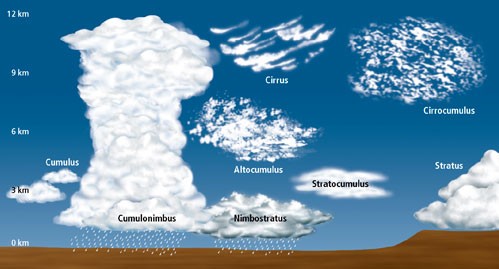Clouds are visible masses of water droplets or ice crystals that are suspended in the Earth’s atmosphere. They form when warm, moist air rises and cools, causing the water vapor in the air to condense into tiny droplets or ice crystals. Clouds come in various shapes and sizes and can be found at different altitudes in the atmosphere. They play an important role in regulating the Earth’s temperature. In this article, we will study the process of formation and types of clouds.

Table of Contents
Formation of Cloud
Clouds form when warm, moist air rises and cools. As the air cools, the water vapor in the air condenses into tiny water droplets or ice crystals, which then stick together to form clouds. The amount of water vapor in the air and the rate at which it cools determines the size and shape of the clouds.
Stages in Formation of Cloud
Cloud formation is a complex process that involves a series of stages. Here are the stages in the formation of clouds:
- Humidity: The first stage in the formation of clouds is humidity. The air needs to have a certain level of moisture or humidity for clouds to form. This moisture can come from a variety of sources, such as evaporation from oceans, lakes, and rivers, or from plant transpiration.
- Cooling: The second stage in the formation of clouds is cooling. As the moist air rises, it cools down due to a decrease in atmospheric pressure. The rate of cooling depends on the altitude and the amount of moisture in the air.
- Condensation: The third stage in the formation of clouds is condensation. When the moist air cools to its dew point temperature, the water vapor in the air starts to condense into tiny water droplets or ice crystals. This happens when the air temperature drops below the dew point temperature, which is the temperature at which the air is fully saturated with water vapor.
- Nucleation: The fourth stage in the formation of clouds is nucleation. The water droplets or ice crystals need a surface to condense on. Dust, salt, or other particles in the atmosphere act as nuclei for the water droplets or ice crystals to form around.
- Cloud Formation: The fifth and final stage in the formation of clouds is cloud formation. The water droplets or ice crystals continue to grow and combine with each other, forming visible clouds. The type of cloud that forms depend on the altitude, temperature, and humidity levels of the atmosphere.
In summary, cloud formation involves the presence of humidity, cooling of the air, condensation of water vapor, nucleation of water droplets or ice crystals, and finally, the formation of visible clouds.
Types of Cloud
- Cumulus Clouds: These are the puffy, cotton-like clouds that are often associated with sunny days. They are formed by rising warm air and can indicate good weather. However, they can also develop into thunderstorms if the air is unstable.
- Stratus Clouds: These clouds are low-lying and often appear as a gray or white blanket covering the sky. They are formed when moist air is lifted, and they can indicate that a storm is approaching.
- Cirrus Clouds: These are high-altitude clouds that are made up of ice crystals. They are thin, and wispy, and often appear as streaks in the sky. They indicate fair weather but can also be a sign of an approaching storm.
- Cumulonimbus Clouds: These are the largest clouds and are often associated with thunderstorms. They are tall and have a flat top with a dark base. They can produce lightning, thunder, and heavy rain.
- Stratocumulus Clouds: These clouds are low-lying and can appear as rounded masses or patches. They are often associated with light rain or drizzle and can indicate a change in weather.

Conclusion: Formation and Types of Cloud
Clouds are an essential part of our atmosphere and play a vital role in regulating the Earth’s temperature and weather patterns. Understanding the science behind cloud formation and the different types of clouds that exist can help us appreciate and enjoy the beauty of the sky even more. So, the next time you look up at the sky, take a moment to admire the clouds and appreciate the wonder of nature.
Q. Consider the following characteristics of a cloud type :
1. They are born through convection.
2. Only cloud type that can produce hail, thunder, and lightning.
3. They are large cauliflower-shaped towers, often ‘anvil tops’.
Identify the type of cloud on the basis of the given characteristics.
(a) Stratocumulus
(b) Cumulonimbus
(c) Cirrocumulus
(d) Nimbostratus
Important Links